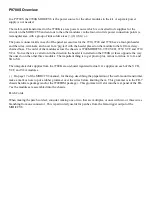
215627
13
Revision A
Chapter 2:
Unloading Windrower
Unload all windrower parts before beginning assembly. Carefully follow these procedures in the order in which they are
presented.
2.1
Using One Forklift to Unload Windrower
Ensure that you use a forklift which meets the minimum length and capacity requirements when unloading the windrower.
WARNING
Equipment used for unloading must meet or exceed the specified requirements. Using inadequate equipment may
result in chain breakage, vehicle tipping, or machine damage.
Table 2.1 Lifting Vehicle Requirements
Minimum Capacity
1
7037 kg (15,500 lb.)
Minimum Fork Length
198.1 cm (78 in.)
IMPORTANT:
Forklifts are normally rated for a load located 610 mm (24 in.) ahead of the back end of the forks. To learn the forklift
capacity when the load sits 122.2 cm (48 in.) ahead of the back of the forks, check with your forklift distributor.
1.
Move the trailer onto level ground and block the trailer wheels.
2.
Set the forklift forks to the widest possible setting.
$
%
&
&
Figure 2.1: Windrower on Trailer
CAUTION
Ensure that the forks do NOT contact fuel tank (A) or
windrower engine oil pan (B) (not shown).
3.
Position the forklift so that it is on the side of the trailer
opposite windrower fuel tank (A).
Position forks (C) under the windrower frame so that fuel
tank (A) sits between the forks.
NOTE:
The windrower
’
s center of gravity is approximately
157.5 cm (62 in.) rearwards from the center of its
drive wheel.
WARNING
Ensure that the forks extend beyond the far side of the frame.
4.
Lift the windrower until it clears the trailer deck.
5.
Slowly back the forklift away from the trailer until the windrower is clear of the trailer deck.
6.
Lower the windrower slowly to the ground. If the ground is soft, place wooden blocks under the front shipping stands.
7.
Carefully back the forklift away from the windrower.
8.
Check the windrower for shipping damage. Check the rest of the shipment for missing parts.
1.
At 122.2 cm (48 in.) from back end of forks.
















































